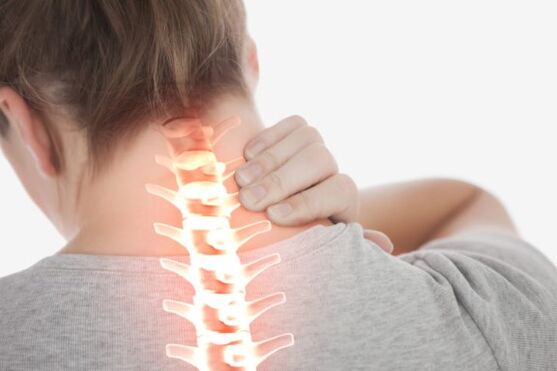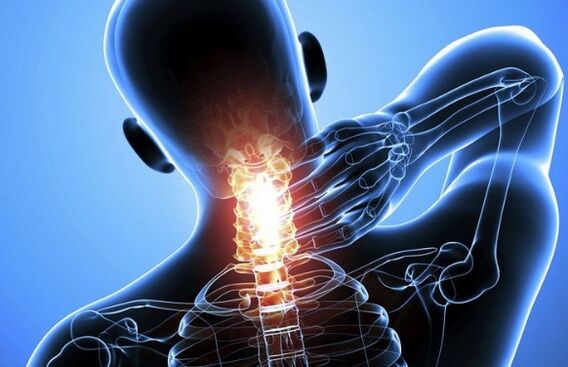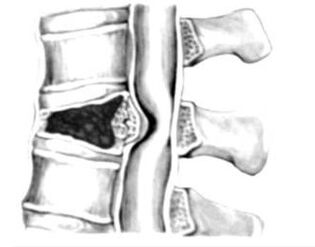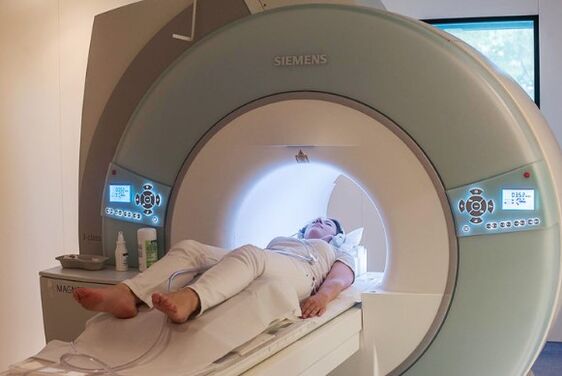Osteochondrosis is a complex of serious degenerative-dystrophic destruction of cartilage tissue between the vertebrae. In this pathological phenomenon, the windows themselves are affected, their changes in height, the bone tissue is damaged in the cervix region.Pathology has similar symptoms with some diseases. The main thing is to notice the first signals of the body in good time and to be diagnosed with the necessary treatment. Otherwise, osteochondrosis begins to cause migraines and circulatory disorders. Basically, pathology develops in people who have reduced motor activity. This is due to the fact that the exchange of mineral salts in the body is disturbed, which leads to a thinning of the connective tissue and a decrease in its strength.

Causal factors for the occurrence of the disease
The neck is the mobile part of the body, so it experiences a constant burden because it is obliged to keep the head in a certain position. Some factors can have a negative impact on this area of the body and form inflammatory processes in the body's connective tissue.
The reasons for the development of pathological deviations in the cervical vertebrae are:
- Non -compliance with the performance rules, which is why the overweight is defined;
- Functional change in the skeletal muscular system;
- Hypodynamics;
- Violation of the neck or spine;
- excessive physical pressure on the spine;
- Stress;
- Physical long -term tension of the neck muscle frame;
- Inheritance;
- Anomalies in bone development.
All of these factors negatively influence the vertebrae of the cervical region and lead to pressure, which leads to an involuntary tonic reduction in smooth and skeletal muscles. This leads to the formation of hemodiscilative processes, to slow down the metabolic functions, the development of functional disorders and degenerative changes in cartilage. The vertebrae begin to deform, acquire a non -standard shape and often go beyond the spine.
Symptoms of the disease
The initial phase of the pathological process is clearly visible due to some signs.
- Cephalgic syndrome. It is formed during cerebral angiospasm, which presses the cerebrospinal cerebral nerves and the background of involuntary intracranial hypertension. It spreads through the occipital part of the head, neck and influences the shoulder area and the upper limbs. Pain syndrome can resemble a longer increase in blood pressure (high blood pressure), an attack by angina pectoris, a violation of brain circulation, and manifest itself in the form of a paroxysmal, constant or pulsating nature. Fear can increase, mood swings, the attention concentration decreases, one person is irritated, sensitive;
- Dizziness occurs, the coordination of movements is disturbed. Everything is accompanied by tinnitus, nausea, vomiting and disorientation. It is not always a sign of this pathology, since it can manifest itself as a result of average or internal medium -ear inflammation media, heart disease, cerebral angiospasm or impairment of nerve cell function. In addition, dizziness is often found with a vestibular disorder;

Important!There are two types of dizziness. With unsystematic dizziness it seems difficult for one person to be in the upright position. At the same time, objects that are in sight do not revolve. And the systemic manifests the circular movement of all objects, which indicates violations in the work of the vestibular apparatus, visual perception and muscle pasms. This is a characteristic sign of dizziness for osteochondrosis.
- Painful manifestations in the neck. Pain sensations are not only located in muscle tissues, but also in the shoulders, including the upper limbs. The occurrence of pain suddenly develops and takes a long time and can have a short time. If the disease did not turn into a relapse, the pain runs after a while, while there is accompanying a minor specific sound (crunch);
- Arterial hypertension. A sharp blood pressure jump occurs when the nerve end is clamped. Therefore, if increased pressure is observed for a long time, this is not a symptom for osteochondrosis. A high pressure in this disease is combined with cephalia, painful pain in the hands, the compression of the breast, the cervical brotherly region of the back loses its sensitivity. The condition of the weakness, fatigue, lack of strength in the muscles of the upper limbs.
Table. Classification of osteochondrosis of the cervix region.
| stage | feature |
|---|---|
| 1 degree | The lordosis of the neck is slightly smoothed. The occurrence of pain that increases while the head is moved. The occurrence of a tense state and a weakness in the muscles of the lumbar industry. |
| 2 degrees | The sizes of the fiber and chrysique formations that compress nerve branches increases. The pain is reinforced in the shoulders, the hands broadcast, when the neck is moved. The Cephalgic syndrome, a feeling of tiredness, distraction, development and performance is reduced. |
| 3 degrees | Pain sensations of constant nature in the upper extremities, in the cervix and in the shoulder hotel. There is muscle weakness, deafness of the limbs. A hernia of intervertebral discs is formed. The neck is inactive, dizziness appears. |
| 4 degrees | Fiber and Chrysline formations are destroyed. The connecting fibers replace the destroyed cartilage. The destructive process can also influence more than a spine. The patient is completely disoriented, pain and dizziness are increasing. |
What is the risk of the disease?

Pathology harms the entire human body. In osteochondrosis, blood vessels, nerve roots are tightly pressed, which leads to a disk management encephalopathy, and the cephalgic syndrome, pathologies of the heart rhythm, visual, respiratory systems, concentration and coordination processes are created.
The disease tends to cause:
- different pathologies of the brain;
- a number of vestibular, vascular, vegetative natural disorders;
- Acute violation of the spine circulation with the development of ischemia or bleeding (spine stroke).
Diagnosis
Opportunities to diagnose violations of intervertebral discs.
- Radiography. Not effective enough in the last stage of the disease.
- Magnetic resonance imaging (MRI). A research method that contains detailed information about the presence of deviations, pathologies of the bone structure, the connective tissue, regardless of whether there is a hernia, with the clarification of its size, position and growth.
- Computer tomography with contrast. Allows you to determine the pathology in the vertebrae. The disadvantage in such a study is the impossibility of determining the presence of the compression of the spinal cord.
- Ultrasound dopperography. The effectiveness of this method is to determine the reduction of the bloodstream by blood vessels.
Features of treatment
When treating osteochondose of the cervix region, they are based on the degree of disease, their characteristic clinical manifestations and form. The treatment can be carried out as:
- Non -surgical therapyThe purpose is to eliminate the symptoms, manifestations of the disease in order to relieve the condition of the patient using medication and physiotherapy, therapeutic exercises, massage;
- surgical intervention;
- Combined therapy. With this method, surgical intervention with further treatment with medication is carried out.

According to a diagnostic examination, the specialist will make a final diagnosis and prescribes the necessary treatment depending on the clinical image of the disease. If the disease is at a stage in which no surgical operation is required, complex therapy is prescribed, including taking medication, the performance of therapeutic exercises and the passage of the healing massage course.
Medication
The doctor prescribes medicines that aim to remove pain symptoms, inflammation and muscle tension, restore cartilage tissue, to fill the body with a vitamin mineral complex in the form of capsules, injections and ointments.
Therapeutic physical culture (training therapy)
Medical physical education is prescribed to restore blood circulation in the cervix region. The movements should not be sharp, with an excessive rotation or bend of the head. It is necessary to imitate the listed movements. Exercises are not carried out for more than two minutes. The treatment complex of exercises includes tendencies of the head to the front and backwards without the action to be carried out to the end.
Basic exercises for the treatment of osteochondrosis.
- The pose of "lies" on the stomach is accepted. The hands rest on the floor and the head and upper body. The back remains straight. It is necessary to be in this position in 2-3 approaches for about two minutes.
- The pose of "lies" on the stomach is accepted. The hands stretch along the body. The head heads are made on the right and left and try to touch the floor with the ear. 6-7 approaches for each side.
- The "seated" pose is accepted. With a inhalation there is a tendency to take the front while trying to stretch his head to the chest. If you exhale, a return to its original position is brought back with a slight inclination of the head. 10-15 approaches are carried out.
- In the "seated" pose, the palms of the hands are applied to the forehead while performing an urgent movement. The head also reaches for the palms and creates the effect of resistance. 2-3 approaches of 30 seconds are carried out.
- Circular movements of the headThis is done very carefully and slowly on the right and left. Ten movements are carried out in each direction to avoid dizziness.
Therapeutic massage
When treating osteochondrosis, the specialist carries out massage movements in the area of the cervix region, in the collar area and in the upper back. This procedure must be carried out in a lying position so that the patient's body is relaxed.
The main techniques of the therapeutic massage:
- Stroke- A technique in which the massive hand glides with low pressure along the skin, captured the area of the head base and moves into the upper back.
- Press- A technique in which a stronger effect on the skin, a subcutaneous tissue and a surface layer of muscles are carried out. The skin of the skin with the fingers occurs carefully and bypasses the periporates.
- Trituration- It consists in the shift and stretching of tissues in different directions in order to warm up the skin and blood flow to the collar area.
- Knead- The most difficult technique that influences the deep muscle tissue. It is only carried out with caution on the recommendation of a doctor, since it can lead to a complication of the disease.

Physiotherapeutic treatment method
Physiotherapy is prescribed to treat the pathology of the intermediate discs of the cervix region.
- Pharmaceutical electrophoresis-Physiotherapeutic ultrasound process that was carried out under sinus -shaped electricity.
- Laser therapy- This is the method of physiotherapy that activates the blood circulation, eliminates the inflammatory process and reduces pain. Laser therapy is carried out to improve blood flow.
- Magnetotherapy- One of the methods based on the treatment of the exposure of magnetic fields, with the influence of fabric removed and pain is eliminated.
- Ultrasonic therapy- With treatment, you can relieve pain, an inflammatory process and at the same time improve blood circulation.
Traditional medicine in the treatment of osteochondrosis of the cervical spine
Folk methods for the treatment of osteochondrosis do not work. This is due to the fact that these methods are able to temporarily relieve symptoms, but not to solve the main problem - the destructive starting effect in the spine. At home, plant components can be used as a support complex for the most important therapeutic treatment defined by the doctor.
You can use for pain in the cervix region:
- Fly leaves (treated with boiling water are applied to focus on pain);
- Raw potatoes and honey (potatoes are grated until the porridge is formed, mixed with honey in the same proportions and applied to the place of inflammation at least once a week);
- Mustard, pepper stain and rubbing with alcohol (used for local irritation, increased blood circulation and removal of pain).

Preventive measures
In order to prevent the occurrence of one of the dangerous diseases, it is necessary to observe certain rules throughout their lives. Many diseases can be prevented after the right lifestyle. However, there are situations in which the disease is inherited, and then it is aware of her health. Nutritional foods that are enriched with vitamins and minerals as well as moderate physical activity help to maintain the body and even stop the development of an initial illness.
Recommendations of doctors who help prevent the appearance of the disease:
- lead an active lifestyle, swim;
- observe the right nutrition;
- Food with calcium, magnesium (seafood, legumes, dairy products, green);
- Perform physical warm ups every day, especially if work is associated with a constant seating position;
- Use special orthopedic pillows and mattress to sleep.
At every age, it is worthwhile to regularly examine the body with osteochondrosis and to carry out a therapeutic physical culture with regular massage. Then you can live long and comfortably with the disease.




















